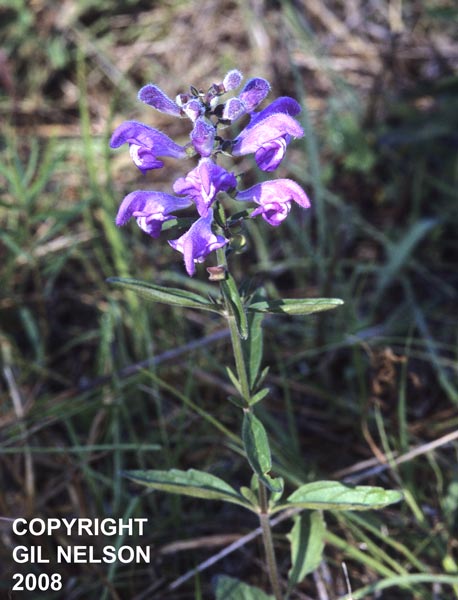Scutellaria integrifolia
| Scutellaria integrifolia | |
|---|---|

| |
| Photo taken by Gil Nelson | |
| Scientific classification | |
| Kingdom: | Plantae |
| Division: | Magnoliophyta – Flowering plants |
| Class: | Magnoliopsida – Dicotyledons |
| Order: | Lamiales |
| Family: | Lamiaceae ⁄ Labiatae |
| Genus: | Scutellaria |
| Species: | S. integrifolia |
| Binomial name | |
| Scutellaria integrifolia L. | |

| |
| Natural range of Scutellaria integrifolia from USDA NRCS Plants Database. | |
Common names: Helmet flower, Helmet skullcap
Contents
Taxonomic notes
Synonyms: none
Varieties: Scutellaria integrifolia var. hispida Bentham; S. integrifolia var. integrifolia
Description
"Perennial herbs with quadrangular, erect to ascending stems; stolons absent, or present and underground. Leaves sessile or petiolate. Racemes bracteate, often paniculate. Calyx zygomorphic, 2-lobed, the upper lobe crested, very small in flower and enlarging in fruit; corolla zygomorphic , upper lip galeate, 3-lobed, lower lip unlobed, usually white in the throat. The blue-flowered species occasionally have white flowered forms. Stamens 4, exserted; stigma 2-parted. Mericarps dark brown to black, closely set with tubercles or papillae in somewhat concentric rings, rounded, often somewhat flattened."[1]
"Plant not stoloniferous, forming clumps of 1-several stems. Stems erect, 1.5-8 dm tall, simple or branched above, pubescent. Lowest leaves triangular-ovate, 0.7-3.5 cm long, 0.2-2 cm wide, obtuse or acute, crenate, base truncate to widely cuneate; petioles 0.8-2.5 cm long. Upper leaves lanceolate to narrowly elliptic, 2.5-6 cm long, acute or obtuse, entire to remotely crenate, base cuneate to attenuate; petioles 0-10 mm long, mostly obscured by blade tissue. Racemes 1-5 rarely more, terminating the stems, 0.3-2 dm long. Lowest bracts often leafy, reduced rapidly upward. Calyx 2.5-3 mm long in flower, 6-8 mm in fruit; corolla blue to violet, 1.3-2.5 cm long. Mericarps dark brown, tuberculate, the tubercles with broad apices, 1-1.5 mm long."[1]
Distribution
Ecology
Habitat
In the Coastal Plain in Florida and Georgia, S. integrifolia can be found next to flowing artesian wells, burned palmetto-slashpine flatwoods, burned longleaf pinewoods, pine savannas, longleaf pine sandhills, mixed woodlands, at the mouth of creeks in swampy woodlands, marshes, creek banks, oak-hickory woods, moist depressions in pine woodlands, Nyssa-Cypress swamps, floodplains, and edges of calcereous glades.[2] It can occur in disturbed sites such as roadside ditches, powerline corridors, hammock slopes, along railroad depressions, peaty ditches bordering flatwoods, swamp clearings, along gas pipe line corridors, and slight seepage swale in cutover upland longleaf pine savannas. Soils include sandy loam, loamy soil, loamy clay, and peaty soils.[2]
S. integrifolia decreased its occurrence in response to soil disturbance by agriculture in southwest Georgia savannas. It has shown resistance to regrowth in reestablished savanna habitat that was disturbed by agricultural practices.[3]
Associated species include Rhexia petiolata, Polygala cruciata, Polygala, Drosera, and Lachnanthes.[2]
Phenology
S. integrifolia has been observed flowering March through July with peak inflorescence in April and May and fruiting March through July and November.[2][4]
Seed dispersal
This species is thought to be dispersed by gravity.[5]
Fire ecology
Populations of Scutellaria integrifolia have been known to persist through repeated annual burning.[6]
Conservation, cultivation, and restoration
Cultural use
Photo Gallery
References and notes
- ↑ 1.0 1.1 Radford, Albert E., Harry E. Ahles, and C. Ritchie Bell. Manual of the Vascular Flora of the Carolinas. 1964, 1968. The University of North Carolina Press. 902. Print.
- ↑ 2.0 2.1 2.2 2.3 Florida State University Robert K. Godfrey Herbarium database. URL: http://herbarium.bio.fsu.edu. Last accessed: July 2015. Collectors: Cecil R Slaughter, Loran C. Anderson, K. Craddock Burks, Robert K. Godfrey, Steve L. Orzell, Edwin L. Bridges, Grady W. Reinert, Andre F. Clewell, R. D. Houk, P. L. Redfearn, Jr., H. Kurz, Jean W. Wooten, E. S. Ford, P. White, Gary R. Knight, Sidney McDaniel, Elmer C. Prichard, Ira L. Wiggins, W. D. Reese, Herbert Monoson, Simpson, L. B. Trott, James D. Ray, Jr., George R. Cooley, Robert Kral, R. J. Eaton, H. Kurz, Ed Keppner, Lisa Keppner, R. A. Norris, R. Komarek, D. C. Hunt, Kevin Oakes. States and Counties: Florida: Alachua, Bay, Charlotte, Clay, Columbia, Escambia, Flagler, Franklin, Gadsden, Holmes, Jackson, Jefferson, Lake, Leon, Manatee, Nassau, Orange, Okaloosa, Osceola, Polk, Putnam, Santa Rosa, Seminole, Volusia, Wakulla, Walton. Georgia: Grady, Thomas. Compiled by Tall Timbers Research Station and Land Conservancy.
- ↑ Kirkman, L.K., K.L. Coffey, R.J. Mitchell, and E.B. Moser. Ground Cover Recovery Patterns and Life-History Traits: Implications for Restoration Obstacles and Opportunities in a Species-Rich Savanna. (2004). Journal of Ecology 92(3):409-421.
- ↑ Nelson, G. PanFlora: Plant data for the eastern United States with emphasis on the Southeastern Coastal Plains, Florida, and the Florida Panhandle. www.gilnelson.com/PanFlora/ Accessed: 13 DEC 2016
- ↑ Kirkman, L. Katherine. Unpublished database of seed dispersal mode of plants found in Coastal Plain longleaf pine-grasslands of the Jones Ecological Research Center, Georgia.
- ↑ Platt, W.J., R. Carter, G. Nelson, W. Baker, S. Hermann, J. Kane, L. Anderson, M. Smith, K. Robertson. 2021. Unpublished species list of Wade Tract old-growth longleaf pine savanna, Thomasville, Georgia.